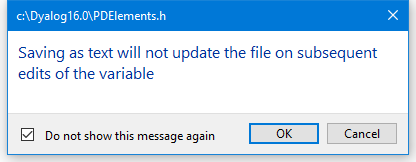The Configuration Dialog Box
General Tab
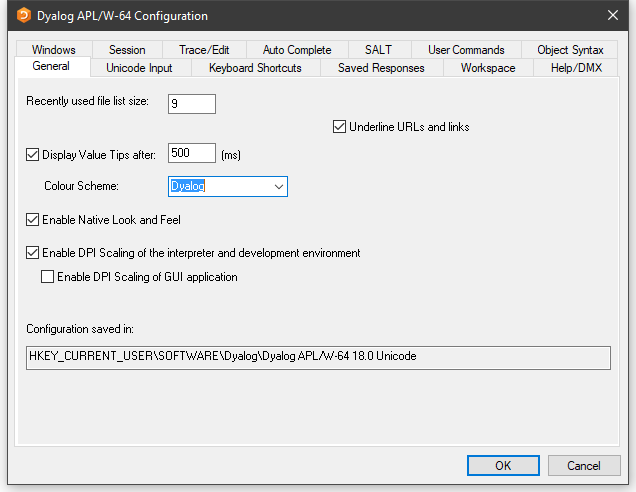
Table 80: Configuration dialog: General
| Label | Parameter | Description |
|---|---|---|
| Recently used file list size | file_stack_size | Specifies the number of the most recently used workspaces displayed in the File menu. |
| Show message box if text wraps | Specifies whether or not a message box is displayed to inform the user when the search wraps. See also: Allow search to wrap. | |
| Underline URLs and links | URLHighlight | Specifies whether or not URLs and links are highlighted in Session and Edit windows. |
| Display Value Tips after | ValueTips/Delay | Specifies the delay before APL will display the value of a variable or the code for a function when the user hovers the mouse over its name. |
| Colour Scheme | ValueTips/ ColourScheme |
Specifies the colour scheme used to display the value of a variable or the code for a function when the user hovers the mouse over its name. |
| Enable Native Look and Feel | XPLookAndFeel | Specifies whether or not Native Look and Feel is enabled. This changes the appearance of user-interface controls such as Buttons in both the Session and the Dyalog GUI. |
| Enable DPI Scaling of the interpreter and development environment | AUTODPI | Enables or disables DPI scaling for the APL Session |
| Enable DPI scaling of GUI application | DYALOG_PIXEL_TYPE | Sets the value of the DYALOG_PIXEL_TYPE parameter which determines whether Coord 'Pixel' is treated as ScaledPixel or RealPixel. |
| Configuration saved in | inifile | Specifies the full pathname of the registry folder used by APL |
Underline URLs and links
If this option is selected, valid URLs are identified when the cursor is in the Session or in an Edit or Trace window. When the mouse pointer is over a URL, the URL is underscored and the appropriate items in the Session Popup menu are activated. These allow you to open the link or copy it to the clipboard.
You may also open a URL using Ctrl+Click (Left Mouse button).
Currently a URL string is defined to be a string starting with any of the following strings:
- http://
- https://
- www.
- mailto:
Unicode Input Tab (Unicode Edition Only)
Unicode Edition can optionally select your APL keyboard each time you start APL.
To choose this option, select one of your installed APL keyboards, enable the Activate selected keyboard checkbox, then click OK

Input Method Editor Properties

Table 81: Dyalog APL Input Method Editor Properties
Notes
The UseCSV parameter is defined for the IME in the Registry section HKEY_CURRENT_USER\Software\Dyalog\UnicodeIME\
When UseCSV is 1, the keystrokes Ctrl+X, Ctrl+C and Ctrl+V are passed untranslated to dyalog.exe which treats them as CT, CP and PT respectively. This is likely to be true for other host applications using the Dyalog keyboard.
The standard Dyalog keyboard (*.din) files map Shift+Del to CT, Ctrl+Ins to CP, and Shift+Ins to PT. These will therefore work independently of the UseXCV option.
The standard Dyalog keyboard (*.din) files map BOTH Ctrl+X and Ctrl+Shift+Xto ⊃ So if UseCSV is set to 1, you must use Ctrl+Shift+X to obtain ⊃. Likewise for C and V.
Input Tab (Classic Edition Only)
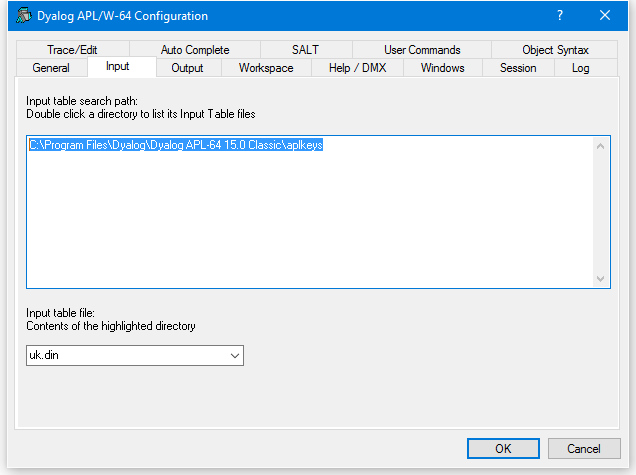
Table 82: Configuration dialog: Keyboard
| Label | Parameter | Description |
|---|---|---|
| Input table search path | aplkeys | A list of directories to be searched for the specified input table |
| Input table file | aplk | The name of the input table file (.DIN) |
Output Tab (Classic Edition Only)
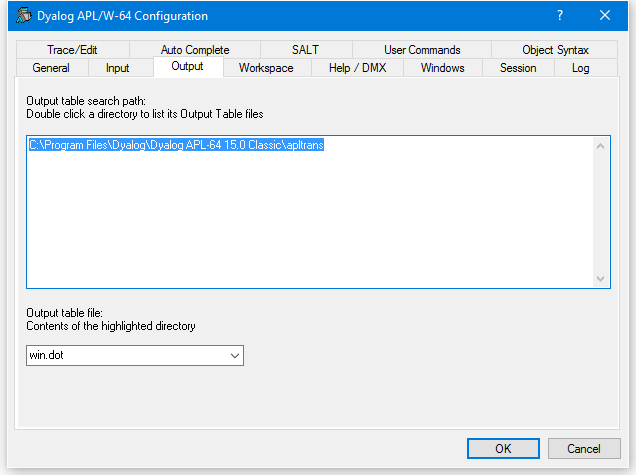
Table 83: Configuration dialog: Output
| Label | Parameter | Description |
|---|---|---|
| Output table search path | apltrans | A list of directories to be searched for the specified output table |
| Output table file | aplt | The name of the output table file (.DOT) |
Keyboard Shortcuts Tab
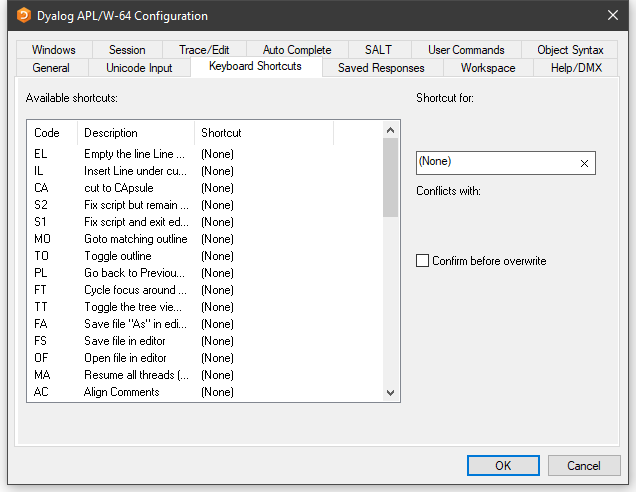
To alter the keystroke associated with a particular action, simply select the action required and press the keystroke. For example, to change the keystroke associated with the action <UA> (undo all changes) from (None) to Ctrl+Shift+u, simply select the corresponding row in the list and press Ctrl+Shift+u. If Confirm before Overwrite is checked, you will be prompted to confirm or cancel before each and every change is written back to the registry.
Note that clicking on the column headings will sort on that column; shift and mouse click will sort in reverse order.
Workspace Tab

Table 84: Configuration dialog: Workspace
Note
Workspace size is specified by an integer value followed by one of K, M, or G which stand for Kilobytes, Megabytes and Gigabytes respectively. If no character is included, units default to K (Kilobytes). MAXWS defaults to 64M on the Raspberry Pi, and 256M on all other platforms.
Help/DMX Tab
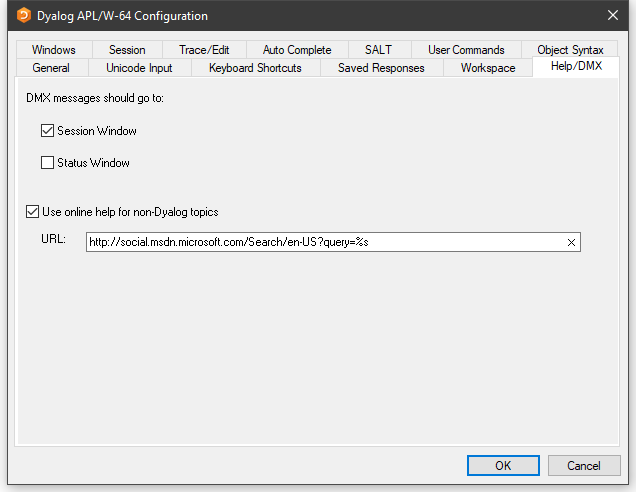
Table 85: Configuration dialog: Help/DMX
Windows Tab
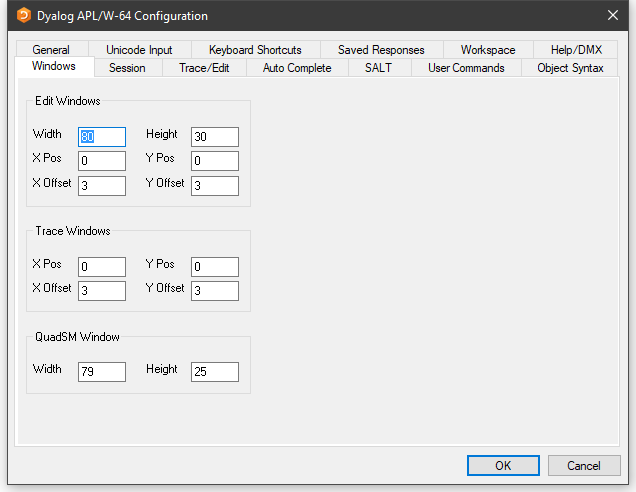
Table 86: Configuration dialog: Windows (Edit Windows)
Table 87: Configuration dialog: Windows (Trace Windows)
Table 88: Configuration dialog: Windows (QuadSM Window)
| Label | Parameter | Description |
|---|---|---|
| Width | sm_cols | The width of the ⎕SM and prefect windows. |
| Height | sm_rows | The height of the ⎕SM and prefect windows. |
Session Tab
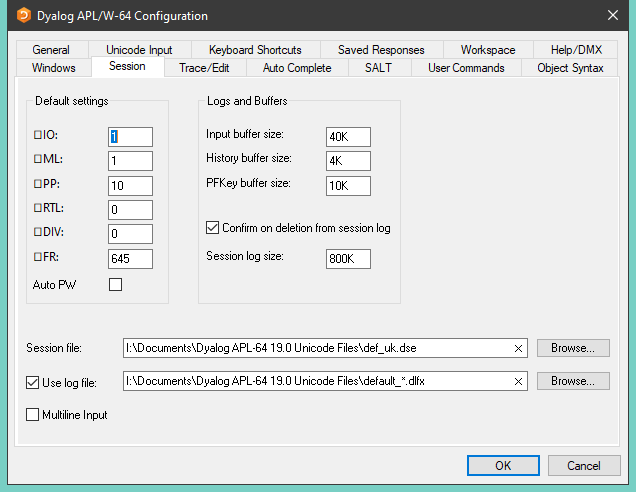
Table 89: Configuration dialog: Session
Note: The value of size-related values defined in the above table is specified as an integer value followed by one of K, M, G, T, P or E. The default, where no character is included, is K (Kilobytes).
Trace/Edit Tab
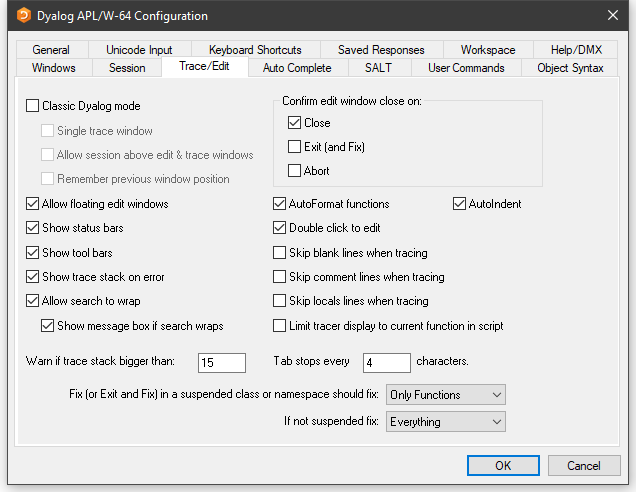
Table 90: Configuration dialog: Trace/Edit
| Label | Parameter | Description |
|---|---|---|
| Classic Dyalog mode | ClassicMode | Selects pre-Version 9 behaviour for Edit and Trace windows. Note that in this mode, a maximum of 50 Trace windows may be displayed. |
| Allow session above edit windows | SessionOnTop | Specifies whether or not the Session may appear on top of Edit and Trace Windows |
| Single trace window | SingleTrace | Specifies whether or not there is a single Trace window |
| Remember previous window position | ClassicModeSavePosition | Specifies whether or not the current size and location of the first of the editor and tracer windows are remembered in the registry for next time. |
| Allow floating edit windows | DockableEditWindows | Allows individual Edit windows to be undocked from (and re-docked in) the main Edit window |
| Show status bars | StatusOnEdit | Specifies whether or not status bars are displayed along the bottom of individual Edit windows |
| Show tool bars | ToolBarsOnEdit | Specifies whether or not tool bars are displayed along the top of individual Edit windows |
| Show trace stack on error | Trace_on_error | Specifies whether or not the Tracer is automatically invoked when an error or stop occurs in a defined function |
| Allow search to wrap | WrapSearch | Specifies whether or not Search/Replace in the Editor stops at the top or bottom of the text, or continues from the start or end as appropriate. See also: Show message box if text wraps. |
| Warn if trace stack bigger than | Trace_level_warn | Specifies the maximum stack size for automatic deployment of the Tracer. |
| Confirm edit window close on Close | confirm_close | Specifies whether or not a confirmation dialog is displayed if the user alters the contents of an edit window, then closes it without saving |
| Confirm edit window close on Edit (and Fix) | confirm_fix | Specifies whether or not a confirmation dialog is displayed if the user alters the contents of an edit window, then saves it using Fix or Exit |
| Confirm edit window close on Abort | confirm_abort | Specifies whether or not a confirmation dialog is displayed if the user alters the contents of an edit window, then aborts using |
| Autoformat functions | AutoFormat | Selects automatic indentation for Control Structures when function is opened for editing |
| Autoindent | AutoIndent | Selects semi-automatic indentation for Control Structures while editing |
| Double-click to Edit | DoubleClickEdit | Specifies whether or not double-clicking over a name invokes the editor |
| Skip blank lines when tracing | SkipBlankLines | If enabled, this causes the Tracer to automatically skip blank lines. |
| Skip comment lines when tracing | SkipBlankLines | If enabled, this causes the Tracer to automatically skip comment lines. |
| Limit tracer display to current function in script | AddClassHeaders | When Tracing the execution of a function in a script, the Tracer displays either just the first line of the script and the function in question (option enabled), or the entire script (option disabled). |
| Paste text as Unicode (Classic Edition only) |
UnicodeToClipboard | Specifies whether or not text transferred to and from the Windows clipboard is to be treated as Unicode |
| Tab stops every | TabStops | The number of spaces inserted by pressing Tab in an edit window |
| Exit and fix ... | InitFullScriptSusp | See Fixing Scripts below |
| If not ... | InitFullScriptNormal | See Fixing Scripts below |
Fixing Scripts
When using the Editor to edit a script such as a Class or Namespace you can specify whether, when you Fix the script and Exit the Editor, just the functions in the script are re-fixed, or whether the whole script is re-executed, thereby re-initialising any Fields or variables defined within.
These two actions always appear in the Editor File menu, but you can specify which is associated with the <EP> (Esc) key by selecting the appropriate option in the drop-downs labelled:
- Exit and save changes (EP) in a suspended class or namespace should fix:
- If not suspended fix:
In both cases, you may select either Only Functions or Everything.
The label for the corresponding items on the Editor File menu (see UI Guide: Editor (The File Menu, editing a script)) will change according to which behaviour applies. Note that if you specify a keystroke for <S1> in the Keyboard Shortcuts tab, this will be associated with the unselected action.
Auto Complete Tab
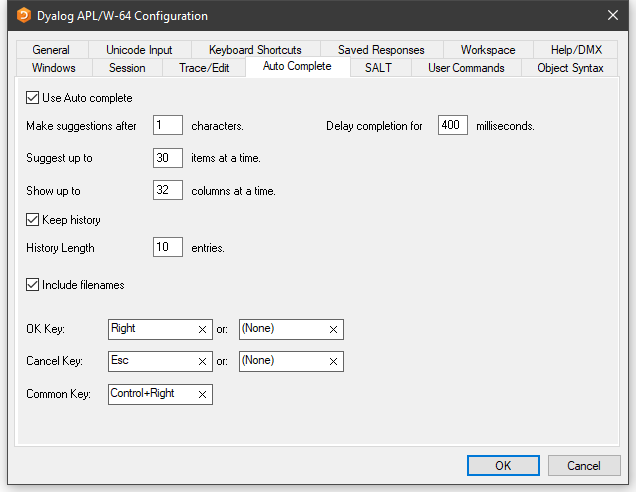
Note: To enter values in the OK Key and Cancel Keyfields, click on the field with the mouse and then press the desired keystroke.
Table 91: Configuration dialog: Auto Complete
SALT Tab
SALT is the Simple APL Library Toolkit, a simple source code management system for Classes and script-based Namespaces. SPICE uses SALT to manage development tools which "plug in" to the Dyalog session
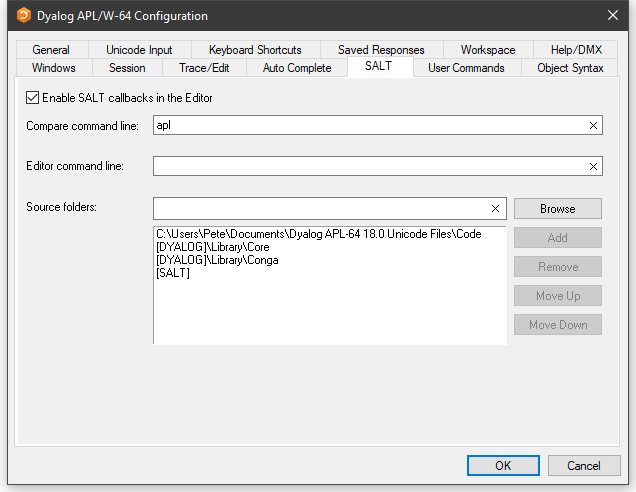
Table 92: Configuration dialog: SALT
| Label | Parameter | Description |
|---|---|---|
| Enable Salt |
AddSALT | Specifies whether or not SALT is enabled |
| Compare command line: |
CompareCMD | The command line for a 3rd party file comparison tool to be used to compare two versions of a file. See note. |
| Editor command line: | Editor | Name of the program to be used to edit script files (default "Notepad"). |
| Source folders: |
SourceFolder | Sets the SALT working directory; a list of folders to be searched for source code. Include "." on a separate line to include source files from the current working directory |
User Commands Tab
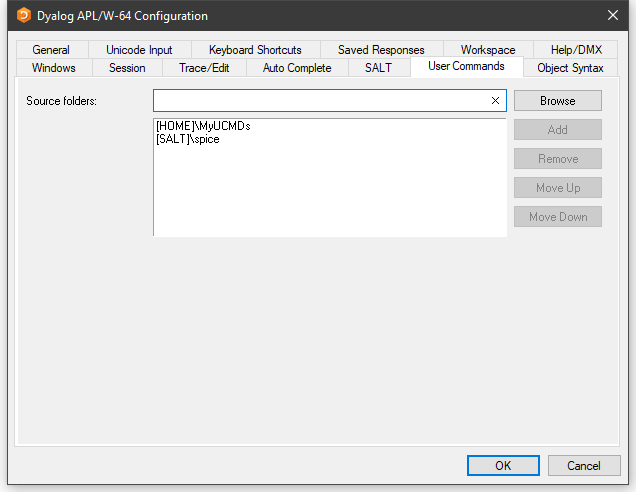
This page is used to specify and organise a list of folders that contain User-Command files. When you issue a User Command, these folders will be searched for the source of the command in the order in which they appear in this list.
Table 93: Configuration dialog: User Commands
| Label | Parameter | Description |
|---|---|---|
| Source Folders | SALT\CommandFolder | Use this field to add folders to the list of folders that will be searched for User Commands. |
Object Syntax Tab
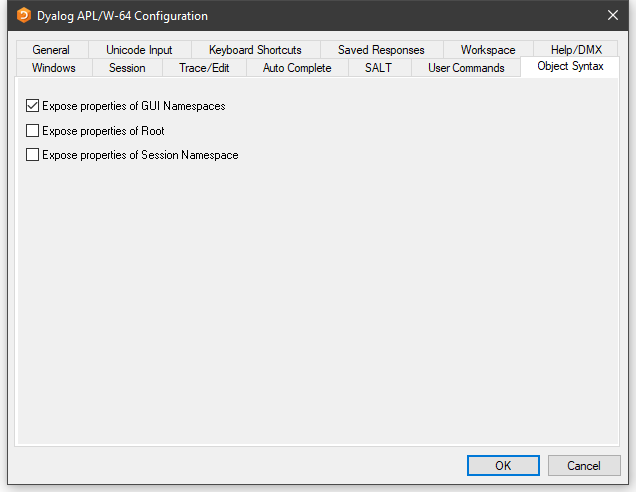
The Object Syntax tab of the Configuration dialog is used to set your default preferences for Object Syntax.
The Object Syntax settings for the current workspace are reflected by the Object Syntax submenu of the Options menu. Use Options/Object Syntax to change them. These settings are saved in the workspace.
Table 94: Configuration dialog: Object Syntax
Saved ResponsesTab
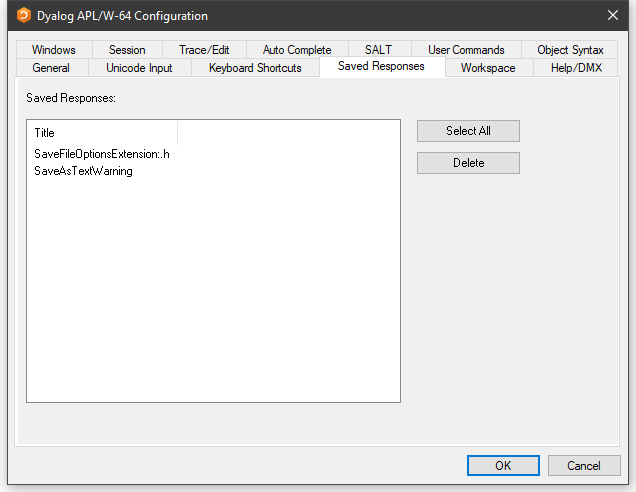
The Saved Responses tab of the Configuration dialog is used to remove preferences that the user has previously established.
In the example illustrated above, the user has at some point chosen to save a text file with a .h extension as text in the workspace and, by checking the option Save this response for all files with a ".h" extension, saved this as a preference for all such text files. Similarly, the user has checked the option Do not show this message again when responding to the warning dialog Saving as text will ....
If the user wishes to reverse these decisions, even temporarily, it is necessary to select the corresponding option /preference name(s) and click Delete. The names are intended to be self-explanatory and are not listed here.

